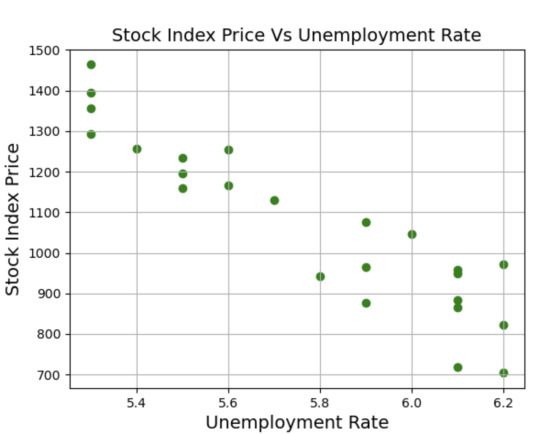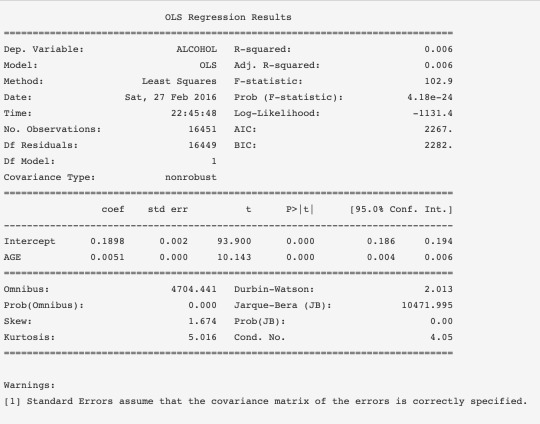Text
t3_3
As you can see, a linear relationship also exists between the Stock_Index_Price and the Unemployment_Rate – when the unemployment rates go up, the stock index price goes down

0 notes
Text
t3_2
You’ll notice that indeed a linear relationship exists between the Stock_Index_Price and the Interest_Rate. Specifically, when interest rates go up, the stock index price also goes up:

0 notes
Text
t3_1
In the following example, we will use multiple linear regression to predict the stock index price (i.e., the dependent variable) of a fictitious economy by using 2 independent/input variables:
Interest Rate
Unemployment Rate
In our example, you may want to check that a linear relationship exists between the:
Stock_Index_Price (dependent variable) and Interest_Rate (independent variable)
Stock_Index_Price (dependent variable) and Unemployment_Rate (independent variable)
0 notes
Text
t1
My problem is about modeling how R&D, administration, and marketing spendings and the state will influence the profit of a company. There are 50 startups data in my dataset.
import numpy as np
import pandas as pd
import matplotlib.pyplot as plt
dataset = pd.read_csv(“50_Startups.csv”)
X= dataset.iloc[:, :-1].values
Y=dataset.iloc[:, 4].values
from sklearn.preprocessing import LabelEncoder, OneHotEncoder
labelencoder_X = LabelEncoder()
X[: ,3]= labelencoder_X.fit_transform(X[: ,3])
onehotencoder= OneHotEncoder(categorical_features=[3])
X= onehotencoder.fit_transform(X).toarray()
X= X[:, 1:]
from sklearn.model_selection import train_test_split
X_train, X_test, Y_train, Y_test = train_test_split( X, Y, test_size=0.2, random_state=0)
from sklearn.linear_model import LinearRegression
regressor = LinearRegression()
regressor.fit(X_train,Y_train)
y_pred= regressor.predict(X_test)
0 notes
Text
t3
The precision is the ratio tp / (tp + fp) where tp is the number of true positives and fp the number of false positives. The precision is intuitively the ability of the classifier to not label a sample as positive if it is negative.
The recall is the ratio tp / (tp + fn) where tp is the number of true positives and fn the number of false negatives. The recall is intuitively the ability of the classifier to find all the positive samples.
The F-beta score can be interpreted as a weighted harmonic mean of the precision and recall, where an F-beta score reaches its best value at 1 and worst score at 0.
The F-beta score weights the recall more than the precision by a factor of beta. beta = 1.0 means recall and precision are equally important.
0 notes
Text
t2
Observations:
The average age of customers who bought the term deposit is higher than that of the customers who didn’t.
The pdays (days since the customer was last contacted) is understandably lower for the customers who bought it. The lower the pdays, the better the memory of the last call and hence the better chances of a sale.
Surprisingly, campaigns (number of contacts or calls made during the current campaign) are lower for customers who bought the term deposit.
The frequency of purchase of the deposit depends a great deal on the job title. Thus, the job title can be a good predictor of the outcome variable.
In some situations, the features have little impact on the result. So that it should be eliminated some of the independent variables to prevent the shadow on the output. We build the optimal model using Backward Elimination
The backward elimination function will give us the optimal variables from my data
0 notes
Text
The dataset comes from the UCI Machine Learning repository, and it is related to direct marketing campaigns (phone calls) of a Portuguese banking institution. The classification goal is to predict whether the client will subscribe (1/0) to a term deposit (variable y). The dataset can be downloaded from here.
import pandas as pd
import numpy as np
from sklearn import preprocessing
import matplotlib.pyplot as plt
plt.rc("font", size=14)
from sklearn.linear_model import LogisticRegression
from sklearn.model_selection import train_test_split
import seaborn as sns
sns.set(style="white")
sns.set(style="whitegrid", color_codes=True)
The dataset provides the bank customers’ information. It includes 41,188 records and 21 fields.
Input variables
age (numeric)
job : type of job (categorical: “admin”, “blue-collar”, “entrepreneur”, “housemaid”, “management”, “retired”, “self-employed”, “services”, “student”, “technician”, “unemployed”, “unknown”)
marital : marital status (categorical: “divorced”, “married”, “single”, “unknown”)
education (categorical: “basic.4y”, “basic.6y”, “basic.9y”, “high.school”, “illiterate”, “professional.course”, “university.degree”, “unknown”)
default: has credit in default? (categorical: “no”, “yes”, “unknown”)
0 notes
Text
Variables
Explanatory: S1Q4A, age at first marriage.
Response: ETOTLCA2, average daily volume of ethanol consumed in past year, from all types of alcoholic beverages combined.
Quantitative: 14-94 years, 31794 samples
Unknown values (99) and never married people are discarded.
Quantitative: 0.0003-219.955 oz. ethanol/day
Unkwnown values are discarded observations. Could be mapped to the mean, but don't add much.
0 notes
Text
Code of progr
%matplotlib inline
import numpy as np
import pandas as pd
import statsmodels.formula.api as smf
import seaborn as sns
import matplotlib.pyplot as plt
data = pd.read_csv('../datasets/NESARC/nesarc_pds.csv', usecols=['S1Q4A','ETOTLCA2'])
df = pd.DataFrame()
df['AGE'] = data['S1Q4A'].replace(' ',np.NaN).replace('99',np.NaN).astype(float)
df['ALCOHOL'] = data['ETOTLCA2'].replace(' ',np.NaN).astype(float)
df = df.dropna()
print('Original')
print(df.describe())
df['AGE'] = df['AGE']- df['AGE'].mean()
print('\n\nCentered AGE')
print(df.describe())
fig, (ax1,ax2)= plt.subplots(1,2)
bp_age = sns.boxplot(x='AGE',data=df, whis=1.5, orient='v', ax=ax1)
bp_alcohol = sns.boxplot(x='ALCOHOL',data=df, whis=1.5, orient='v', ax=(ax2))
plt.subplots_adjust(bottom=0.1, right=1.8, top=1.5)
fig.show()
def outlier_limits(data, whis=1.5):
q3 = np.percentile(data, 75)
q1 = np.percentile(data, 25)
iqr = q3-q1
return(
q1-(whis*iqr),
q3+(whis*iqr),
)
0 notes
Text
Variables
Explanatory: S1Q4A, age at first marriage.
Response: ETOTLCA2, average daily volume of ethanol consumed in past year, from all types of alcoholic beverages combined.
Quantitative: 14-94 years, 31794 samples
Unknown values (99) and never married people are discarded.
Quantitative: 0.0003-219.955 oz. ethanol/day
Unkwnown values are discarded observations. Could be mapped to the mean, but don't add much.
0 notes
Text
Statistics work t3
The response variables in my investigation are the years during which I measured the unemployment rates in different countries and the explanatory variables are the indexes of unemployment.
I found a strong connection between the level of country development and the rate of unemployment. The connection was found by creating a scatterplot and seeing the trends between paired data.
0 notes
Text
Statistics work t2
I was really interested is there any connection between the level of country developing and the unemployment rate and there is. I just surfed the necessary information on this theme in the Internet and found such an useful information. The data takes 20 years starting from 2001 till 2020. The statistic information is collected in 50 countries with different level of development.
0 notes
Text
Statistics work t1
In my work I decided to take indexes of unemployment in twenty years in 50 European countries.
I used official statistics website for taking all the information among the years and countries.
1 note
·
View note







